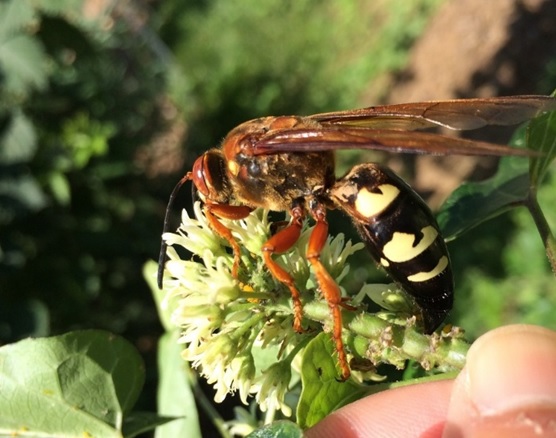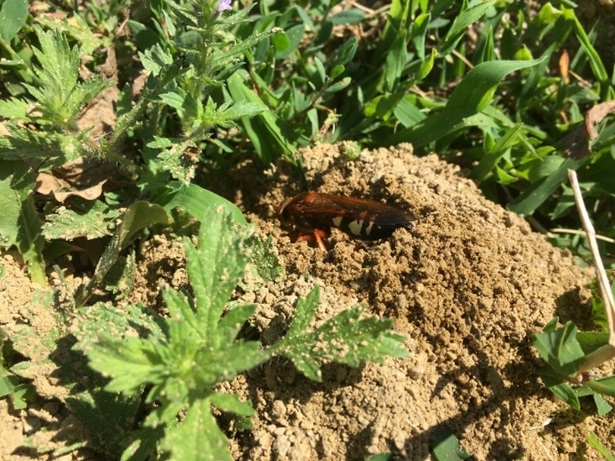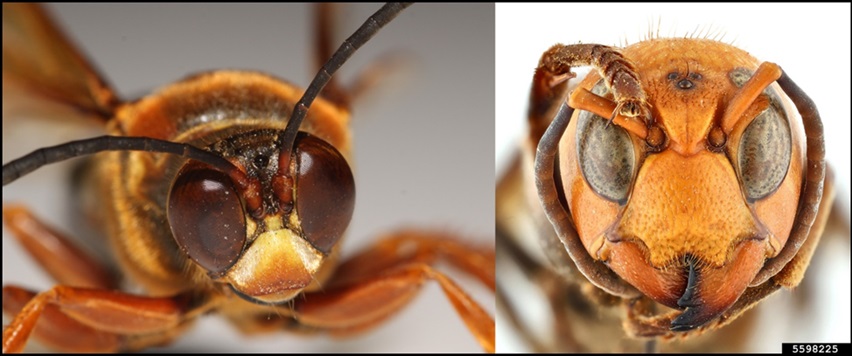Cicada Killer Wasps
ENTFACT-004: Cicada Killer Wasps | Download PDF
by Jonathan L. Larson, Extension Entomologist
University of Kentucky College of Agriculture
Fast Facts
- Cicada killers are large, imposing wasps; females can be nearly 2 inches long and males are around 1.5 inches and.
- Adult wasps are most commonly seen in July and August. Female cicada killers capture annual cicadas and bury them in tunnels they have dug. They can cause damage to lawns and other areas through their tunnel construction.
- Despite their large size, cicada killers are not considered stinging hazards unless they are directly disturbed.
- Control is not necessary or typically feasible. If absolutely necessary, physically killing wasps with a swatter or tennis racket or applying insecticidal dusts into tunnels may kill some wasps. For annual issues, the only long-term solution will be renovations to the landscape that reduce attraction.
Symptoms and Pest Description
The first thing most people notice when cicada killers utilize their landscape will be large male wasps hovering in the air. Males emerge before females and will stake out areas where they believe females may be. Males will “inspect” humans, hovering at eye level to evaluate you.
Following this, people often notice large piles of sand or loose soil building up near retaining walls or in turf or landscape beds. This is the result of excavation done by female wasps to create tunnels that they will use for their egg-laying. The tunnels can be 12-15 inches deep in the soil and up to 36 inches long.
Adult cicada killers are large wasps. Females are the larger of the two sexes, ranging between 1.5 and nearly 2 inches long. Males are to 1.5 inches long. The coloration transitions from dark orange on the head and thorax, gradually darkening to black on the abdomen. There are three light-yellow stripes on the abdomen and their legs and wings usually have an orange tinge to them
Female cicada killers are equipped with a stinger that they use to inject venom into a cicada they catch and then lay their eggs on top of. They also have spurs on their back legs to help them dig tunnels, where they bury the cicadas. Male cicada killers do not have a stinger, instead they have a non-stinging pseudostinger.


Life Cycle in Kentucky
Cicada killers overwinter as pupae in the tunnels constructed by their mothers. In late June and July, males will begin to emerge and wait for females to arrive. As female wasps emerge, mating occurs and then females begin to dig the tunnels they will use for oviposition. Females will then hunt for annual cicadas that emerge July and August. They can capture these while in flight and then sting the cicadas to paralyze them. Following this, they will transport the cicada back to their nest. This can involve dragging the cicada or carrying it up into tall plants and then jumping and gliding toward the nest.
Once the cicadas are deposited into the tunnel, the female lays an egg that will hatch, and the resulting larva will feed on the provided cicada. Much like a mason bee, the female will construct multiple cells in each burrow. Once the nest is full the female will seal the entrance and the eggs will hatch. Larvae develop over two weeks and will then pupate for the winter.
Potential Issues
Cicada killers frighten many people that encounter them. They are large and imposing and the males do invade personal space. Females are mild mannered compared to other wasps though. They do not have a social nest, meaning a nest that contains a queen and workers (like honey bees or yellowjackets), and are therefore less defensive than other wasps. Stings can occur but are almost always the result of a human directly stepping on or grasping the wasp. Males, even though they seem aggressive, have no stinger to attack with.
Since 2020, cicada killer wasps are often confused for the Asian giant hornet, more famously known as the “murder hornet”. The species do share a similar coloration, shape, and size profile. However, the cicada killer does not present the hazard that is associated with the Asian giant hornet. The Asian giant hornet is also not known to occur in North America outside of the Pacific Northwest. Closer inspection of the two species will also reveal that Asian giant hornets have larger heads than cicada killers, with larger jaws and smaller eyes, also helping to differentiate the species
Management
Generally, management is unnecessary, Cicada killers do not present a true sting hazard and the issues associated with their tunnel building are mostly aesthetic.
In situations where they are causing excessive amounts of damage (usually by smothering out turf with dirt piles) or when their populations are high enough to reduce the usability or lawns or playgrounds there are options for reducing the population. First, physically destroying wasps with a swatter or tennis rackets can help to cut down on individuals and discourage populations. While it sounds comical to try and kill bugs with a tennis racket, it has long been a standby for cicada killer reduction. In other instances, applying a dust insecticide directly into tunnels can coat the soil and kill females as they crawl through. Bifenthrin (in Sevin Dust for one example) is one possible product that can be applied into tunnels using a disposable turkey baster (that will never subsequently be used for food preparation) or can be applied with the spout on the container. Liquid insecticides applied to the turf and soil above the tunnels will not help reduce populations.
Cicada killers also have preferences for where they build. They want well-drained, light-textured soils in full sunlight. Therefore, changing your landscape with wood or stone mulches, creating shade, or increasing irrigation in a specific area can cause them to disperse and try to build elsewhere.

Revised: 2/22
CAUTION! Pesticide recommendations in this publication are registered for use in Kentucky, USA ONLY! The use of some products may not be legal in your state or country. Please check with your local county agent or regulatory official before using any pesticide mentioned in this publication.
Of course, ALWAYS READ AND FOLLOW LABEL DIRECTIONS FOR SAFE USE OF ANY PESTICIDE!
Images: University of Kentucky Entomology unless otherwise specified.
